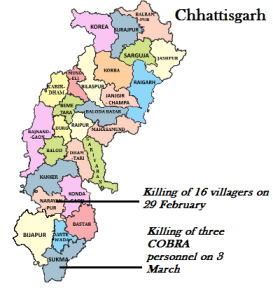MANTRAYA BRIEF#13: 05 MARCH 2016
CPI-Maoist’s continuing potency
Bibhu Prasad Routray
–
Abstract
Killing of 16 civilians in the worst massacre since 2013 and another three security force personnel in Chhattisgarh by the CPI-Maoist brings back attention on the potency of a declining extremism. The state’s continued achievements in neutralising its cadres does not appear to have dented its capacities to carry out selective and well-planned strikes.
–
Killing of 16 villagers and three security force personnel by the Communist Party of India-Maoist (CPI-Maoist) in a matter of four days in Chhattisgarh raises the important question: Does the extremist outfit, despite its current state of weakness, continue to remain a potent adversary?
In the first incident, 16 villagers were accused as police informers and killed after being tried in a people’s court in the Narayanpur district on 29 February. This is the worst massacre to have been carried out by the CPI-Maoist since 2013, when it had targeted workers and leaders of the Congress Party and killed 27 persons. The police came to know of the incident two days later. This speaks of an abysmal lack of administrative and security presence in a large area surrounding the location of the incident. In the second incident, on 3 March, three personnel of the Central Reserve Police Force (CRPF)’s COBRA commando unit were killed and 13 injured including the commander of the battalion in an encounter with Maoists in the southernmost Sukma district. While two personnel were killed on the spot, the third succumbed to his injury later.
These two strikes came somewhat against the run of play – a series of achievements by the state against the extremists. Between 2010 and 2015, 19,531 CPI-Maoist cadres have been neutralised.
These two strikes came somewhat against the run of play – a series of achievements by the state against the extremists. On 1 March, eight suspected Maoists, including five women, were killed in an encounter with security forces in a forest near Telangana-Chhattisgarh border in a joint operation by the CRPF personnel, Chhattisgarh police and Greyhounds personnel of Telangana police. Those killed in the encounter are suspected members of the Venkatapuram area committee of the outfit that operates in Bhadachalam in Khammam district in Telangana and had assembled in the area for a meeting. On 2 March, 23 CPI-Maoist cadres including three who carried a reward of INR 100,000 each on their head had surrendered before the Bastar police. Notwithstanding the fact many of the surrender episodes in Chhattisgarh have remained acutely controversial, loss of cadres through killings, arrests and surrender have indeed affected the CPI-Maoist’s operations. According to available official data, between 2010 and 2015, 19,531 CPI-Maoist cadres have been neutralised (killed, arrested and surrendered). The severe depletion of its cadre strength has been acknowledged by the outfit in a number of its publications.
The security force establishment over time has attempted to label these as acts of desperation. However, close examination of most Maoist violence points otherwise.
And yet, extremist strikes continue to occur. In the first two months of the year (not including the 29 February) killing, the CPI-Maoist has managed to kill 30 security forces and civilians in various states.
- On 8 January, a Border Security Force (BSF) officer and a soldier were killed in Koraput district of Odisha.
- On 27 January, seven police personnel were killed and eight others were injured in a landmine blast by the CPI-Maoist in Palamu district.
The security force establishment over time has attempted to label these as acts of desperation. However, close examination of most Maoist violence points otherwise. Lets analyse the last two attacks.
Firstly, killing of police informers with an objective of cleansing support for the state among the tribals has remained frequently-resorted-to strategy of the extremists. As many as 1352 people branded as police informers have been killed by the extremists between 2008 and 2015. Secondly, on 3 March, Maoists took on the well trained COBRA personnel and inflicted three deaths on them. The COBRA personnel were operating along with the District Reserve Group (DRG) of the Chhattisgarh police were on a search mission when they came under attack. The encounter lasted for over 12 hours and teams attempting to evacuate the injured security force personnel came under repeated attacks by the extremists. Clearly, the attack points at some serious level of strategic planning, which the outfit is still capable of. Sukma remains one of the six districts worst affected by left-wing extremism.
In spite of the sizeable security force presence and pro-active operations, Chhattisgarh’s tryst with Maoist violence remains far from over.
–
Bibhu Prasad Routray is Director, Mantraya.org. This brief is published under Mantraya.org’s “Mapping Terror and Insurgent Networks” project.



